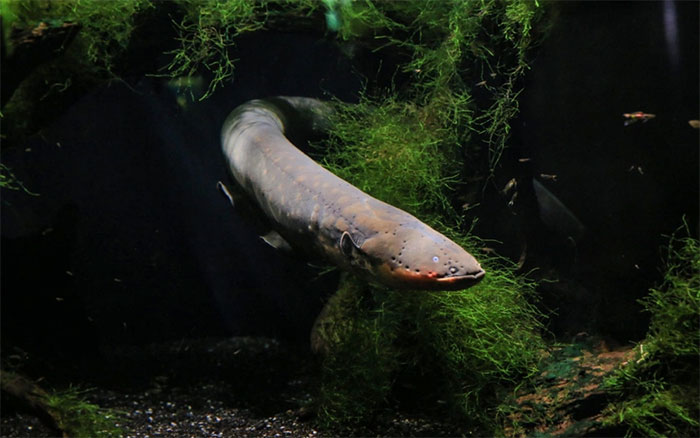Earth's most powerful electric eel may be holding 'keys to the future'
The electric eel inspired physicist Alessandro Volta to invent the first battery, and it is also "paving the way" for upgrading current battery technology.
As the world's demand for portable power sources increases, researchers have sought to upgrade current battery technology, according to the Daily Beast.
Italian physicist Alessandro Volta exploited the basic principles of electrochemistry when he invented the first battery in 1800.
Essentially, the combination of two different materials, usually metals, creates a chemical reaction that causes the flow of electrons to move from one material to another. That flow of electrons represents portable energy, which can be harnessed to generate electricity.
The first materials humans used to make batteries were copper and zinc. The best batteries available today, which produce the highest electrical output in the smallest possible size, bond metallic lithium to one of a number of different metal compounds. Many improvements have been made over the decades, but modern batteries are still based on the same approach to Volta.
Inspired by electric eel
Before the Volta battery, the only way to generate electricity was to rub materials together, typically silk on glass, and collect the static electricity. This is not an easy and practical way to generate useful electrical energy.
Volta knew electric eels had a special internal organ used to generate electricity. He reasoned that if he could mimic it, he could find a new way to generate electricity.
The electricity-generating organ of an electric eel consists of stacked cells that look a lot like a coin coil. So the physicist Volta cut coin-like disks from different sheets of material and started stacking them in different sequences to see if electricity could be generated.

The electric eel inspired Volta to create the first battery.
However, these experiments did not lead to a breakthrough until he tried to match copper plates with zinc plates, while separating them with paper soaked in salt water.
This chain generated electricity by accident, and the power output corresponds to the height of the stack. Volta thinks he's discovered the secret of how electric eels generate electricity, and he's actually created a simulated version of the animal's power-generating organ. So he initially called his discovery 'artificial electric organ'. However, that is not the case.
For now, scientists understand that the electrochemical reactions between the different materials in Volta's experiment have nothing to do with how the eels generate electricity. Instead, it uses an approach similar to how human neurons generate electrical signals, but much larger.
Specialized cells in the organism's electricity-generating organs pump ions across a semi-permeable membrane to create a charge difference between the inside and outside of the membrane.
When the microscopic gates in the membrane open, the rapid flow of ions from one side of the membrane to the other induces an electric current. Eels can simultaneously open all membrane gates at will to create a huge electric current, then launch to target prey.
Further efforts
Electric eels do not shock their prey to death. They only stun with electricity before attacking. An eel can generate hundreds of Volts of electricity, but its amperage doesn't last long to kill prey. Each electrical pulse from an eel lasts only a few milliseconds and transmits less than an ampere.
Like Volta, some modern scientists have also found their inspiration in electric eels to transform battery technology.

Physicist Volta presents the battery he invented to King Napoleon.
A team of scientists from the US and Switzerland is working on a new battery inspired by electric eels. They hope one day, the energy from this battery will be useful in powering medical implants and soft robots. However, the team admits that they have a long way to go.
'The organs that generate electricity in electric eels are very sophisticated. They bring much better energy than we do,' said Michael Mayer, a member of the research team from the University of Fribourg. So research on electric eels continues.
In 2019, the Nobel Prize in Chemistry was awarded to three scientists who developed lithium-ion batteries. In awarding the prize, the Royal Swedish Academy of Sciences asserted that their work had 'laid the foundation for a "wireless", fossil fuel-free society'.
That statement is partly true because lithium-ion batteries now power virtually all portable wireless devices. However, the claim regarding the 'fossil fuel-free society' still needs further follow-up, as today's lithium-ion batteries are recharged with electricity, which is normally generated by burning fuel. fossil.
But later that year, scientists from the Smithsonian Institution announced the discovery of a new species of South American electric eel. This is considered the most powerful biological "generator" known on Earth.
The researchers recorded an eel's discharge at 860 Volts, much higher than the discharge of the previous record-holder eel.
- Electric cars that once shone 100 years ago, die now and will explode in the future
- Van electric cars with design from the future
- Decode the meaning of the logo of the Faraday Future supercar electric supercar 1000 horsepower
- The future of electric aircraft
- Two giant gas planets are transforming into super-Earths
- 11 predicts the future of Elon Musk, all will surprise you
- Revealing electric pickup truck running 645km with just one charge
- The reason why Tesla became the face of future cars
- The formation and development of locks and keys
- Google shares its anti-hacking know-how: using physical keys
- The powerful wireless charging design can fully charge an electric car in 20 minutes
- Sweden launches the world's first electric expressway
 Animal 'suffering' after hibernation
Animal 'suffering' after hibernation Why do goats climb well?
Why do goats climb well? Scientists were surprised to see chimpanzees eating turtles
Scientists were surprised to see chimpanzees eating turtles Giant catfish died deadly due to drought in Thailand
Giant catfish died deadly due to drought in Thailand